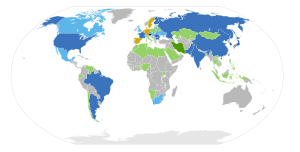- Nuclear power in Thailand
-
 Planned locations for nuclear power plants in Thailand are
Planned locations for nuclear power plants in Thailand are
1. Nakhon Si Thammarat
2. Surat Thani
3. Trat
4. Nakhon Sawan
5. Ubon RatchathaniThe nuclear program of Thailand consists of a plan to build up to five nuclear power plants in Thailand.
Contents
Power Demand
Pricha Karasuddhi, technical adviser for the Nuclear Power Programme Development Office stated that power demand will double in the next 12 years. If the government goes for nuclear power, it must make a decision now to pave the way for preparation. It is crucial to put this on the national agenda, to draw participation from all parties and raise public acceptance. According to the Electricity Generating Authority of Thailand, daily demand for electricity hit 10 new peaks last year. The latest was registered on May 10, 2010 at 24,009MW, higher than the record of 22,044MW on April 24, 2009 - due to higher temperatures and economic recovery. Egat is worried about power blackouts or brownouts in the next 10 years when demand rises against a limited increase in new supply.[1] Nuclear power is expected to reduce Thailand's naturalgas consumption in power generation from 70 per cent to 40 per cent.[2] Figures from 2007 reveal that Thailand used natural gas to generate electricity more than any energy source at 66.2%, followed by lignite at 12.6%. Hydro power accounted for 5.5%, bunker oil 2.7%, diesel 0.03% and renewable energy 1.6%. Imported coal accounted for 8.4%, while purchased electricity from Laos and Malaysia was at 3%.[3]
Recent Developments
Currently a feasibility study on a national nuclear power plant grid will be submitted to the government in 2011. The study is being made by Burns & Roe Asia. The Ministry of Energy still needs more information from other bodies such as the Energy Regulatory Commission. Meanwhile, the law supporting the development is not yet ready.
Power Development Plan 2010
Under the Power Development Plan 2010, five nuclear plants with a combined 5,000 megawatts of capacity are foreseen, feeding power into the grid from 2020. The plan is part of the governments aim to diversify fuel risks, given that 70 per cent of power generation in Thailand is currently fuelled by natural gas, and the remainder by coal and hydropower.
The five nuclear plants are scheduled to feed power in 2020, 2021, 2023, 2025 and 2027 respectively. To meet the schedule, the implementation phase must take place between this year and 2013, so that construction can begin from 2014 to 2019.Fukushima 1 Respond
On March 14, 2011 Prime Minister Abhisit Vejjajiva ordered the Energy Ministry to review its plan to establish five nuclear power plants. The ministry has been instructed to study two issues in detail:
- Emergency measures and nuclear plants
- Potential as terrorist targets
Concern is mounting given the problems in Japan, if Thailand is to adopt the Japanese model. Even with high technology, Japan has not yet been able to restore the cooling system.[4]
Proposed power plant locations
Out of 17 potential locations, the study shortlisted five sites, one each in:
The last of these is where public resistance is the least, as the nuclear plant would be located within the premises of the Sirindhorn Dam, which is a major asset of the Electricity Generating Authority of Thailand. The authority would be assigned under the plan to handle the development of the plants.[5]
Controversy
On March 15, 2011 about 2,000 people from 18 districts of Kalasin Province rallied outside the city hall to protest against the Electricity Generating Authority of Thailand's (EGAT) plan to build a nuclear plant in their province. Banners were raised to denounce some MPs in the province for having asked EGAT to build a nuclear plant in the province and claiming that it was the wish of the people. Well MPs claimed the people agreed to having the nuclear plant at public hearings which in fact had never been held, they said. The protesters said groundwork for the construction of a nuclear plant had been underway near Non Somboon village in tambon Hua Hin of Kalasin's Huay Mek district. The construction site is less than 10km from the Lam Pao river, the lifeline of Kalasin.[6] On March 26, 2011 Abac poll at the Assumption University reported that more than 80% of the respondents (83.4%) disagreed with the plan to construct nuclear power plants in Thailand. The poll involved 3,807 peopled aged 18 up in 17 provinces, was conducted from March 1 to 25, 2011. Bangkok residents had the largest percentage of the objection of 95.2 per cent followed by those in southern region (91.5%), the central (91.1%), the North (90.0%) and the Northeast (85.8%). It should be marked that this poll was conducted during the Fukushima I nuclear accidents in Japan.[7]
References
- ^ http://www.nationmultimedia.com/2011/03/21/business/Decision-needed-soon-on-nuclear-power-30151383.html Decision needed soon on nuclear power
- ^ http://www.nationmultimedia.com/home/Decision-on-nuclear-power-will-be-for-next-Govt-Wa-30148771.html
- ^ http://www.bangkokpost.com/news/local/228677/thailand-power-choices-get-harder Thailand's power choices get harder
- ^ http://www.nationmultimedia.com/2011/03/15/national/Thailand-reviews-N-power-30150908.html PM wants rethink of plan to build 5 nuclear plants as global doubts soar
- ^ http://www.nationmultimedia.com/2011/03/15/business/Mixed-views-on-effect-of-Japanese-reactor-blasts-o-30150903.html Mixed views on effect of Japanese reactor blasts on Thai
- ^ http://www.bangkokpost.com/breakingnews/226826/kalasin-people-against-nuke-plant Kalasin people rally against nuke plant
- ^ http://www.bangkokpost.com/breakingnews/228728/poll-people-against-nuclear-plant Poll: People against nuclear plant
Nuclear power by country GWe > 10 Canada · China · EU (France · Germany · United Kingdom) · Japan · Russia · South Korea · Ukraine · United States
GWe > 2 EU (Belgium · Czech Republic · Finland · Spain · Sweden) · India · Republic of China (Taiwan) · SwitzerlandGWe > 1 GWe < 1 Planned Phasing-out Opposed Categories:- Science and technology in Thailand
- Nuclear energy in Thailand
Wikimedia Foundation. 2010.
